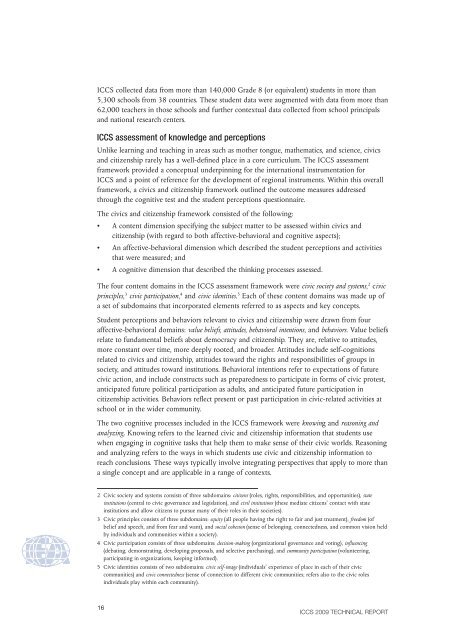ICCS 2009 Technical Report - IEA
ICCS 2009 Technical Report - IEA
ICCS 2009 Technical Report - IEA
- No tags were found...
Create successful ePaper yourself
Turn your PDF publications into a flip-book with our unique Google optimized e-Paper software.
<strong>ICCS</strong> collected data from more than 140,000 Grade 8 (or equivalent) students in more than5,300 schools from 38 countries. These student data were augmented with data from more than62,000 teachers in those schools and further contextual data collected from school principalsand national research centers.<strong>ICCS</strong> assessment of knowledge and perceptionsUnlike learning and teaching in areas such as mother tongue, mathematics, and science, civicsand citizenship rarely has a well-defined place in a core curriculum. The <strong>ICCS</strong> assessmentframework provided a conceptual underpinning for the international instrumentation for<strong>ICCS</strong> and a point of reference for the development of regional instruments. Within this overallframework, a civics and citizenship framework outlined the outcome measures addressedthrough the cognitive test and the student perceptions questionnaire.The civics and citizenship framework consisted of the following:• A content dimension specifying the subject matter to be assessed within civics andcitizenship (with regard to both affective-behavioral and cognitive aspects);• An affective-behavioral dimension which described the student perceptions and activitiesthat were measured; and• A cognitive dimension that described the thinking processes assessed.The four content domains in the <strong>ICCS</strong> assessment framework were civic society and systems, 2 civicprinciples, 3 civic participation, 4 and civic identities. 5 Each of these content domains was made up ofa set of subdomains that incorporated elements referred to as aspects and key concepts.Student perceptions and behaviors relevant to civics and citizenship were drawn from fouraffective-behavioral domains: value beliefs, attitudes, behavioral intentions, and behaviors. Value beliefsrelate to fundamental beliefs about democracy and citizenship. They are, relative to attitudes,more constant over time, more deeply rooted, and broader. Attitudes include self-cognitionsrelated to civics and citizenship, attitudes toward the rights and responsibilities of groups insociety, and attitudes toward institutions. Behavioral intentions refer to expectations of futurecivic action, and include constructs such as preparedness to participate in forms of civic protest,anticipated future political participation as adults, and anticipated future participation incitizenship activities. Behaviors reflect present or past participation in civic-related activities atschool or in the wider community.The two cognitive processes included in the <strong>ICCS</strong> framework were knowing and reasoning andanalyzing. Knowing refers to the learned civic and citizenship information that students usewhen engaging in cognitive tasks that help them to make sense of their civic worlds. Reasoningand analyzing refers to the ways in which students use civic and citizenship information toreach conclusions. These ways typically involve integrating perspectives that apply to more thana single concept and are applicable in a range of contexts.2 Civic society and systems consists of three subdomains: citizens (roles, rights, responsibilities, and opportunities), stateinstitutions (central to civic governance and legislation), and civil institutions (these mediate citizens’ contact with stateinstitutions and allow citizens to pursue many of their roles in their societies).3 Civic principles consists of three subdomains: equity (all people having the right to fair and just treatment), freedom (ofbelief and speech, and from fear and want), and social cohesion (sense of belonging, connectedness, and common vision heldby individuals and communities within a society).4 Civic participation consists of three subdomains: decision-making (organizational governance and voting), influencing(debating, demonstrating, developing proposals, and selective purchasing), and community participation (volunteering,participating in organizations, keeping informed).5 Civic identities consists of two subdomains: civic self-image (individuals’ experience of place in each of their civiccommunities) and civic connectedness (sense of connection to different civic communities; refers also to the civic rolesindividuals play within each community).16<strong>ICCS</strong> <strong>2009</strong> technical report
















